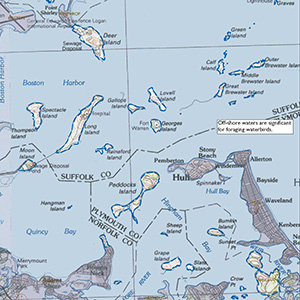Important Bird Area Sites in Massachusetts
Important Bird Area: Boston Harbor Islands National Recreation Area
Site Summary
Nominated By
Peter Paton
Size
1,600 (land) acres
Towns and Counties
Boston, Hingham, Hull, Weymouth, Winthrop; Norfolk, Suffolk, Plymouth
Ownership
state, federal nonmilitary, municipal, private, nongovernmental organization
Major Habitats
oak-conifer forest, salt marsh, marine/tidal, cobble beach, successional shrubland, uncultivated field, outcroppings
Land Use
nature and wildlife, conservation/land trust, hunting and fishing, other recreation, fisheries/aquaculture, suburban residential, urban/industrial/commercial, research, undeveloped
Serious Threats
non-native plants, water and air pollution, residential/commercial development, disturbance to birds and habitat, recreation development/overuse, hydrologic changes
Minor Threats
introduced animals/feral pets, cowbird parasitism, succession, excessive soil erosion and degradation
IBA Criteria
- Category 1: Sites important for long-term research and/or monitoring projects that contribute substantially to ornithology, bird conservation, and/or education.
- Category 2: Shorebirds: The site regularly supports 1,000 or more shorebirds at one time at a coastal site, during some part of the year, or a significant concentration of shorebirds at one time at a nontidal site. The designation "shorebirds" includes birds such as plovers, sandpipers, snipe, woodcocks, and phalaropes.
- Category 5: Waterfowl: The site regularly supports 500 or more waterfowl at any one time. The designation "waterfowl" includes birds such as loons, grebes, cormorants, geese, ducks, coots, and moorhens.
Site Description
The Boston Harbor Islands National Recreation Area comprises 34 islands ranging in size from less than 1 acre to 274 acres. A variety of habitats, including marine, rock cliff, beach, salt marsh, and forest support many different species in all seasons. Several species of special concern in Massachusetts have been observed on the Islands including: Common and Least Tern, Barn Owl, and Common Loon. The Northern Harrier, a threatened species, also occurs on the islands. Significant numbers of colonial-nesting waterbirds, including Double-crested Cormorants, Black-crowned Night-Herons, and Snowy Egrets have been present for at least two decades. Migratory shorebirds, raptors, and songbirds utilize the harbor islands during the spring and fall, and great flocks of waterfowl overwinter there.
Current Conservation Status
The Boston Harbor Islands are protected under the US National Park service.
Ornithological Significance
Two state-listed species, Common Tern and Least Tern, have breeding sites within the Islands. An estimated 30 Least Tern nests were detected on Rainsford Island during 2001 pilot fieldwork (data attached). Heronries on Sarah Island and Middle Brewster support significant numbers of Snowy Egrets and Black-crowned Night-Herons, both species with high conservation priority in Massachusetts. Double-crested Cormorants also nest in significant numbers in the outer harbor. During migration, large numbers of shorebirds are present, feeding on mudflats and salt marshes. Many species of waterfowl gather in large flocks during the winter. The Massachusetts Division of Fisheries and Wildlife has conducted a Coastal Colonial Waterbird Inventory for three decades, and winter waterbird populations have been censused by Take a Second Look (TASL), a local birding group for 20 years. Summary tables of TASL's data from 1980 to 2001 are included. Heronries at Sarah Island were recently the subject of a research project, and Double-crested Cormorants have been studied extensively in the harbor.
Other Flora or Fauna of Significance
The following were documented by Edward Elliman, contracted botanist, during 2001 inventory work (and previous studies): Seaside Angelica (watch listed), Carolina Crane's bill, Seabeach Dock (threatened), and Showy Goldenrod (watch listed) are present on the Islands. Of the 490 vascular plant species identified by Elliman, 40 percent are non-native. On many islands, non-native plants accounted for 50 percent or more of the total flora.
As documented by Mark Mello of the Lloyd Center for Environmental Studies during 2001 inventory work, a total of 351 species of macrolepidoptera and 37 species of butterfly were identified on the Islands. This includes two moth species of special concern in Massachusetts: Coastal Heathland Cutworm and Spartina Borer. Cicindela sexpunctata was the only tiger beetle encountered.
As mapped in the mid-1990's by the Environmental Protection Agency and the State Department of Environmental Protection, there are five eelgrass beds in the harbor, located in close proximity to the Boston Harbor Islands. Also located in proximity to the Islands are four Areas of Critical Environmental Concern: Weir River, Weymouth Back River, Neponset River Estuary, and Rumney Marshes.
Note: Representatives from the 13- member management board of the Boston Harbor Islands Partnership reviewed the IBA nomination materials and no objections were received.
Data Sources
Hatch, J.J. 2001. Terns nesting in Boston Harbor: the importance of artificial sites. Bird Observer 29: 187-193.
Massachusetts Coastal Colonial Waterbird Inventory 1994-95, compiled by Bradford Blodget, State Ornithologist, Massachusetts Division of Fisheries and Wildlife
Paton, P. Breeding bird data from Boston Harbor Islands pilot study, 2001. (personal comments)
Take a Second Look (TASL) 1996-2001. Winter waterfowl and shorebird data within Boston Harbor.
Additional References:
Blodget, B.G., and J.E. Livingston. 1996. Coastal colony-nesting waterbirds. Massachusetts Wildlife 46:10-20.
Hatch, J.J. 1982. The Cormorants of Boston Harbor and Massachusetts Bay. Bird Observer of Eastern Massachusetts 10: 65-73.
Hatch, J.J. 1982. The heronries of Boston Harbor. Bird Observer of Eastern Massachusetts10: 133-135.
Hatch, J.J. Rapid increase of Double-crested Cormorants nesting in Southern New England.American Birds 38: 984-988.
Nove, J. 2001. Birding the Boston Harbor Islands. Bird Observer 29:173-185.
Parsons, K.C., Schmidt, S.R., and A.C. Matz. 2001. Regional patterns of wading bird productivity in Northeastern U.S. estuaries. Waterbirds 24: 323-330.




